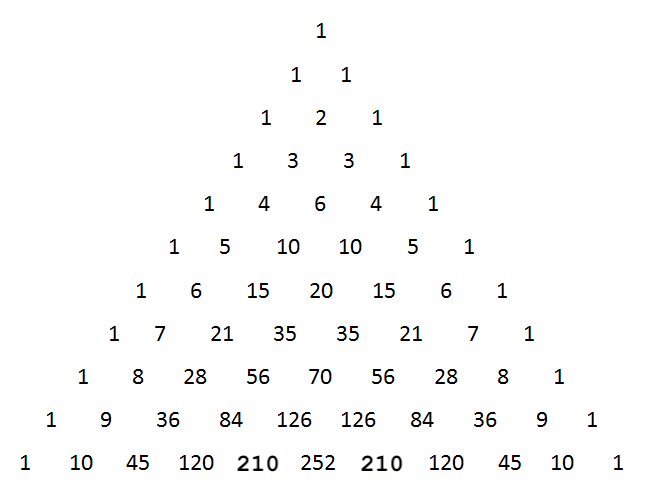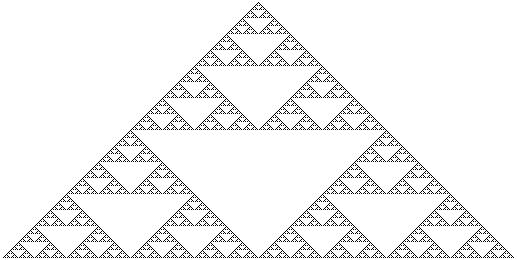Pascal's triangle
Pascal's triangle is a triangle which contains the values from the binomial expansion; its various properties play a large role in combinatorics.
Contents
Properties
Binomial coefficients
Pascal's Triangle is defined such that the number in row ![]() and column
and column ![]() is
is ![]() . For this reason, convention holds that both row numbers and column numbers start with 0. Thus, the apex of the triangle is row 0, and the first number in each row is column 0. As an example, the number in row 4, column 2 is
. For this reason, convention holds that both row numbers and column numbers start with 0. Thus, the apex of the triangle is row 0, and the first number in each row is column 0. As an example, the number in row 4, column 2 is  . Pascal's Triangle thus can serve as a "look-up table" for binomial expansion values. Also, many of the characteristics of Pascal's Triangle are derived from combinatorial identities; for example, because
. Pascal's Triangle thus can serve as a "look-up table" for binomial expansion values. Also, many of the characteristics of Pascal's Triangle are derived from combinatorial identities; for example, because  , the sum of the values on row
, the sum of the values on row ![]() of Pascal's Triangle is
of Pascal's Triangle is ![]() .
.
Sum of previous values
One of the best known features of Pascal's Triangle is derived from the combinatorics identity  . Thus, any number in the interior of Pascal's Triangle will be the sum of the two numbers appearing above it. For example,
. Thus, any number in the interior of Pascal's Triangle will be the sum of the two numbers appearing above it. For example,  . This property allows the easy creation of the first few rows of Pascal's Triangle without having to calculate out each binomial expansion.
. This property allows the easy creation of the first few rows of Pascal's Triangle without having to calculate out each binomial expansion.
Fibonacci numbers
The Fibonacci numbers appear in Pascal's Triangle along the "shallow diagonals." That is,  , where
, where ![]() is the Fibonacci sequence. For example,
is the Fibonacci sequence. For example,  . A "shallow diagonal" is plotted in the diagram.
. A "shallow diagonal" is plotted in the diagram.
Hockey-stick theorem
The Hockey-stick theorem states:
 . Its name is due to the "hockey-stick" which appears when the numbers are plotted on Pascal's Triangle, as shown in the representation of the theorem below (where
. Its name is due to the "hockey-stick" which appears when the numbers are plotted on Pascal's Triangle, as shown in the representation of the theorem below (where ![]() and
and ![]() ).
).
![[asy] int chew(int n,int r){ int res=1; for(int i=0;i<r;++i){ res=quotient(res*(n-i),i+1); } return res; } for(int n=0;n<9;++n){ for(int i=0;i<=n;++i){ if((i==2 && n<6)||(i==3 && n==6)){ if(n==6){label(string(chew(n,i)),(11+n/2-i,-n),p=red+2.5);} else{label(string(chew(n,i)),(11+n/2-i,-n),p=blue+2);} } else{ label(string(chew(n,i)),(11+n/2-i,-n)); } } } [/asy]](http://latex.artofproblemsolving.com/1/5/f/15f56f8b93b4a5a45ce3644c2c13105f8423aa00.png)
Number Parity
Consider writing the row number ![]() in base two as
in base two as ![]()
![]() . The number in the
. The number in the ![]() th column of the
th column of the ![]() th row in Pascal's Triangle is odd if and only if
th row in Pascal's Triangle is odd if and only if ![]() can be expressed as the sum of some
can be expressed as the sum of some ![]() . For example,
. For example, ![]() . Thus, the only 4 odd numbers in the 9th row will be in the
. Thus, the only 4 odd numbers in the 9th row will be in the ![]() th,
th, ![]() st,
st, ![]() th, and
th, and ![]() th columns. Additionally, marking each of these odd numbers in Pascal's Triangle creates a Sierpinski triangle.
th columns. Additionally, marking each of these odd numbers in Pascal's Triangle creates a Sierpinski triangle.
Generalization
This is a special case of Kummer's Theorem, which states that given a prime p and integers m,n, the highest power of p dividing ![]() is the number of carries in adding
is the number of carries in adding ![]() and n in base p.
and n in base p.
Patterns and Properties of the Pascal's Triangle
Rows
The zeroth row has a sum of ![]() . The first row has a sum of
. The first row has a sum of ![]() . The
. The ![]() row has a sum of
row has a sum of ![]()
Diagonals
The 1st downward diagonal is a row of 1's, the 2nd downward diagonal on each side consists of the natural numbers, the 3rd diagonal the triangular numbers, and the 4th the pyramidal numbers.











